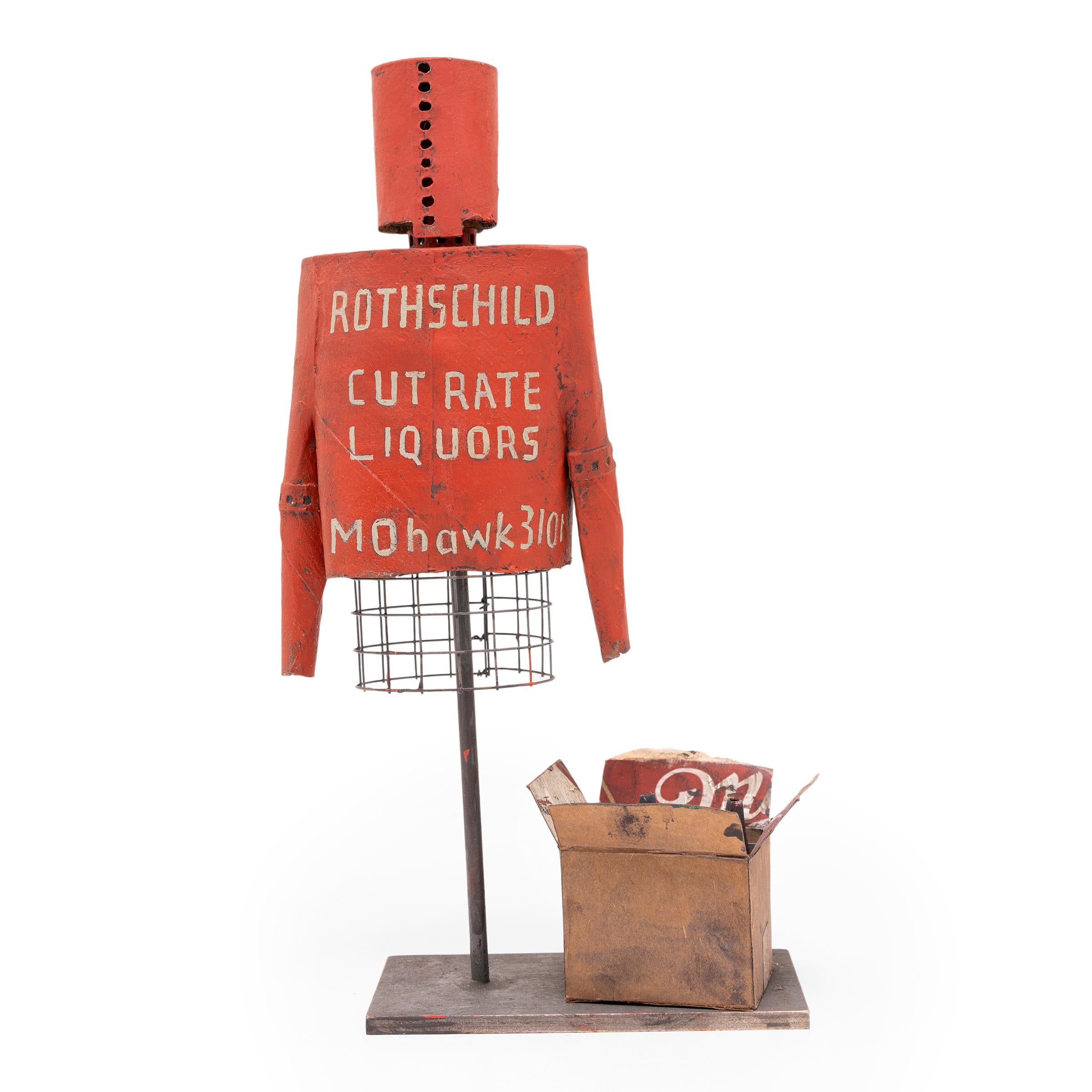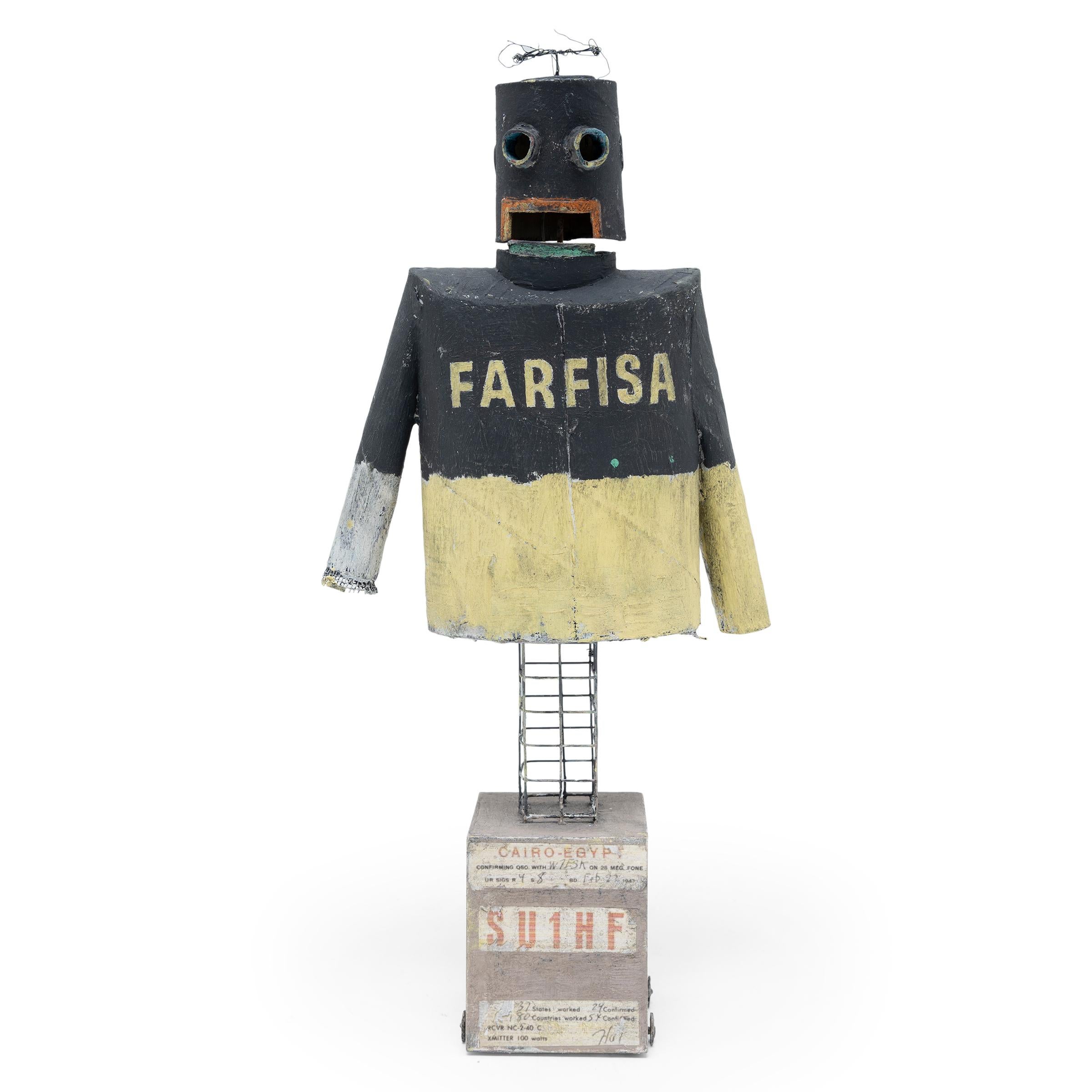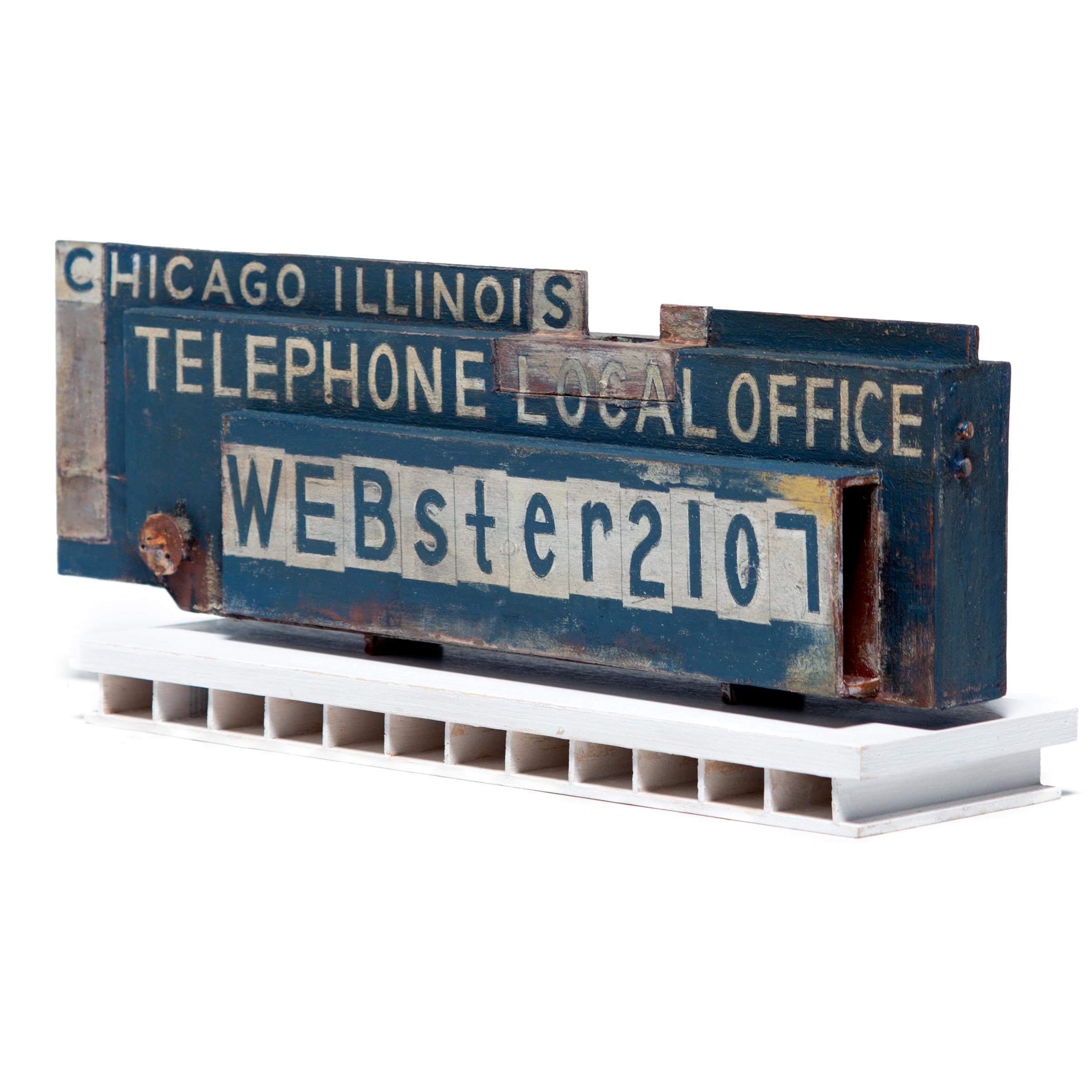Items Similar to Michael German "Leroy & Bertha's Bar and Grill" Mixed Media Sculpture Folk Art
Want more images or videos?
Request additional images or videos from the seller
1 of 12
Michael GarmanMichael German "Leroy & Bertha's Bar and Grill" Mixed Media Sculpture Folk Art
About the Item
SALE ONE WEEK ONLY
During the 1960s America’s storytelling sculptor, Michael Garman, lived a vagabond lifestyle on the cheap and in the run-down neighborhoods of Dallas, San Francisco, Philadelphia and Colorado Springs. Initially, he created one-of-a-kind sculptures. And, as his technique improved, his sculptures became more detailed. Inspired by the people he met on his hitchhiking journey Michael’s early work depicted simple street moments – a tailor mending a garment, a woman on a bench, two ladies gossiping under an umbrella. “Leroy and Bertha’s Bar and Grill” is an example of his enchantment with the underside of life that he had embraced giving him the freedom to move, see and experience whatever he chose.
Born in Fort Worth in 1938 and raised in Arlington, Texas at eight he began creating little pipe-cleaner men. “I would twist pipe cleaners around pipe cleaners to make the muscles, arms and legs, and other features just right,” Michael Garman recalls “I used my mother’s sewing machine to design little cavalry uniforms and cowboy boots. I carved horses out of wood so that some of my guys were mounted. Then I’d gather up all my characters on my bed like a battle scene. I had guns and cannons and horses. Then the great battle began and my hero would get shot. I would arrange him just so, as he was dying. And I would cry and cry for him. I mean, I’d really be sobbing. And then I would scoop them all up and do it over again.”
This story, told by Michael Garman in 1959, was his start becoming America’s Storyteller Sculptor. In ’59 he hitchhiked into Mexico with $35 in his pocket and his Nikon camera for what he thought would be a two-week sojourn. When his money ran out, he would charm his way into a restaurant, offering to sweep the floor or something for a bit to eat or a drink. More often than not, the owner would give him a meal and a place to sleep. “No one I asked hired me, but everyone fed me.”
He hitchhiked his way further south through Central and South America. Two years later, he had traveled all the way to Santiago, Chile where he talked his way for free into the School of Fine Arts. It was here that he discovered his talent for sculpting. “I would sculpt my characters, street people, vendors and such,” Michael Garman relates, “and the school would fire them for free. Then I would go door to door and sell them for five or ten dollars.”
As he had done in South America, as soon as he had a few sculptures finished, he would load them on his motor scooter and sell them door-to-door. Though he eventually made good money, Michael admitted to a growing emptiness. “I began to miss my own work,” he admits. “I discovered that I needed to be surrounded by my little characters, my pals. I still do to this day. I can’t live without my figures around me.”
And so he decided to master the art of reproduction. “Writers do it. Musicians and filmmakers too. Could you imagine if John Steinbeck had only written one copy of The Grapes of Wrath?” Michael asks. “And only one person, one rich muckity-muck was able to read those words?! What a crime that would be. What a loss! As a sculptor, I can do the same thing that a writer or a musician does. I can publish my art. The trick is to make sure that every reproduced copy is just as detailed, just as rich and just as authentic as the original. Sure, it’s hard to master. But it’s supposed to be hard. That’s what makes it fun.”
In the late 1960s, Michael Garman moved into the SoMa (South of Market St. – cheaper area) region of San Francisco where he found a studio above an old print shop. “Man, I landed in the center of wino town,” Garman recalled. “I loved it.” Inspired by the neighborhood, Michael’s sculptures began to become more realistic, gritty, and honest. Soon he began working at a local theatre company. It was here that he learned stage craft, illusion, as well as good business. “It was an important time in my life; that was my Harvard Business School,” Garman relates.
After years spent as a real-life vagabond throughout North and South America, Michael Garman eventually settled in Colorado Springs in 1971. It was here that he perfected his gritty, Americana style. He also began a 40-year project to bring to life his vagabond experiences with a new art form – sculptural theater.
He began work on Magic Town in 1975, and opened it 10 years and 1 million dollars later. “It’s a work-in-progress,” he admitted. And over the following three decades, Michael has added magical illusions, holographic effects, detailed alleyways and more. “Think of a 3,000 square-foot dollhouse,” Michael describes. “A gritty blend of Walt Disney and Norman Rockwell.”
Peek into a window and you might see a woman teaching piano lessons. Then the Magic-Town fade. A few seconds later, the lights come up and all the figures in the scene have changed. Now, as you peer into the window, you discover Michael Garman himself, back in his San Francisco studio sculpting a favorite piece – Flying Leather.
Each scene captures a moment in time – a pool player leans into his shot, hoboes warm themselves by a garbage-can fire, a baseball team celebrates their victory at the local pub, three men sneak into the alley to play craps, and a weary short-order cook steps outside for a smoke break as a pretty girl plays the Wurlitzer.
In addition to building Magic Town, Michael Garman has dedicated the past fifty years to creating hundreds of sculptures that honor American heroes from all walks of life. Among his many sculpture series – Early American, Military, Firefighters, Linemen, Law Enforcement, Western, and many more – a theme emerges. Michael Garman’s art pays tribute to the extraordinary everyday heroes all around us: the firefighters, soldiers and police who run into danger, the doctors who treat our wounds, the lonely cowboy facing the long trail ahead, and the down-but-never-out street character with a twinkle in his eye.
All of his nearly 500 sculptures are reproduced by hand in Colorado Springs. Michael Garman’s inspiration has always been to tell an honest story, and recreate it in an honest way. This is Michael Garman’s “Art for the People.”
- Creator:Michael Garman
- Dimensions:Height: 27.25 in (69.22 cm)Width: 18.75 in (47.63 cm)Depth: 10 in (25.4 cm)
- Medium:
- Movement & Style:
- Period:
- Condition:
- Gallery Location:Detroit, MI
- Reference Number:1stDibs: LU128618595532
About the Seller
5.0
Gold Seller
These expertly vetted sellers are highly rated and consistently exceed customer expectations.
Established in 2014
1stDibs seller since 2019
95 sales on 1stDibs
Typical response time: 3 hours
- ShippingRetrieving quote...Ships From: Detroit, MI
- Return PolicyA return for this item may be initiated within 14 days of delivery.
More From This SellerView All
- "El Tren" Ceramic, Glaze, Colors, Mexican Folk Art, Four SectionsLocated in Detroit, MISALE ONE WEEK ONLY "El Tren" is a whimsical and playful rendition of a train. It is beautifully glazed in various colors. This particular ceramic was from the collection of Jane and Richard Knight’s Estate. Jane Knight was a famous fiber and textile artist. Richard was a photographer who worked for Eliel Saarinen and Alexander Girard. The Knights and Girard became close friends and it was Girard who gifted “Santa Cruz De Las Huertas Jalisco” to the Knights. Alexander Girard left his personal collection to the Museum of International Folk Art, Santa Fe, NM. The Girards eventually amassed a collection of more than 106,000 objects from across the globe. Their 1978 gift of this collection to the Museum of International Folk art quintupled the size of their collection and prompted the construction of a new wing, which opened in 1982 and houses a mere 10% of the Girard Collection in the permanent exhibition Multiple Visions: A Common Bond, which was designed by Alexander Girard himself. This collection includes numerous multiples and is notable for its great breadth, including traditional arts, popular arts, and paper ephemera. “I believe we should preserve this evidence of the past, not as a pattern for sentimental imitation,” Girard once said, “but as nourishment for the creative spirit of the present.” Indeed, folk art was an important inspiration for Girard’s design work. The renowned Candelario Medrano...Category
1950s Folk Art Still-life Sculptures
MaterialsCeramic, Glaze
- “Santa Cruz de las Huertas Jalisco”, Ceramic, Glaze, Colors, Mexican FolkartLocated in Detroit, MISALE ONE WEEK ONLY “Santa Cruz de las Huertas Jalisco” is a whimsical, charming and colorfully ceramic rendition painted blue and red of a local bus that traversed the town where the artist Candelario Medrano...Category
Mid-20th Century Folk Art Figurative Sculptures
MaterialsCeramic, Glaze
- "Kryptonite Wares", Found Objects 2015/2019, Chartreuse & Red, House PaintLocated in Detroit, MISALE ONE WEEK ONLY "Kryptonite Wares" is a clever and humorous collection of both superfluous and everyday objects purchased from the Dollar Store. It is a wry comment by the artist...Category
2010s Assemblage Still-life Sculptures
MaterialsPlastic, House Paint, Wood, Found Objects, Lights, Mixed Media
- "Barcus Burlwood Vase I" Turned Burlwood Polished Rough, Glass InsertLocated in Detroit, MIThis turned Burlwood vase has rich earth tones with copper highlights. The swirling burl pattern comes through the glossy surface that contrasts with the...Category
1970s Modern Still-life Sculptures
MaterialsWood
- Jerome Ferretti "Record Player" Symphonic Record Player SpeakersLocated in Detroit, MISALE ONE WEEK ONLY "Record Player" by Jerome Ferretti, Detroit muralist, painter and sculptor, is a genuine Symphonic Record Player with built...Category
1990s American Modern Still-life Sculptures
MaterialsAcrylic, Wood
- Palissy Majolica Bowl Snake Spider Frog Caterpillar Butterfly LizardLocated in Detroit, MIThis Jose A Cunha Portuguese Palissy Majolica plate features a snake, spider, frog, caterpillar, and butterfly on green shredded clay ground. The piece bears the maker's marks for Jose A Cunha pottery. Palissy ware is a style of ceramics that is also known as rusticware due to their earth-toned palettes and naturalistic plant and animal scenes that are cast to it. The style was coined in reference to the 16th century French potter Bernard Palissy and experienced a significant revival in the 19th century thanks to Charles-Jean Avisseau. It's strongest revival however was in Portugal where it was produced by the potteries of Mafra, Jose A. Cunha, Alves, José Francisco de Sousa...Category
19th Century Still-life Sculptures
MaterialsMajolica, Glaze, Earthenware
You May Also Like
- "Case Runner, " Mixed Media Sculpture, 2022Located in Chicago, ILTo Chicago-based artist Patrick Fitzgerald, his sculptures are a means of traveling through time. Working from found materials, Fitzgerald constructs miniature soap box cars...Category
21st Century and Contemporary Outsider Art Figurative Sculptures
MaterialsWire
- "Grocery Getter, " Mixed-Media on Cardboard, Wire, and Wood, 2022Located in Chicago, ILTo Chicago-based artist Patrick Fitzgerald, his sculptures are a means of traveling through time. Working from found materials, Fitzgerald constructs miniature soap box cars...Category
21st Century and Contemporary Outsider Art Still-life Sculptures
MaterialsWire
- "Senzo Titulo (Michelangelo Antonioni), " Mixed-media Sculpture, 2022Located in Chicago, ILTo Chicago-based artist Patrick Fitzgerald, his miniature car sculptures are a means of traveling through time. Born from a fascination with the soap box...Category
21st Century and Contemporary Outsider Art Figurative Sculptures
MaterialsWood, Paper, Mixed Media, Oil
- "Rock-Ola Car, " Mixed-Media Sculpture, 2019Located in Chicago, ILChicago-based artist Patrick Fitzgerald uses his works as a means of resurrecting the idyllic worlds he once found in the industrial surroundings of his youth. Raised in Grand Rapids...Category
21st Century and Contemporary Outsider Art Figurative Sculptures
MaterialsWood, Paper, Mixed Media, Oil, Acrylic
- "XMITTER, " Mixed-Media on Cardboard, Wire, and Wood, 2022Located in Chicago, ILTo Chicago-based artist Patrick Fitzgerald, his sculptures are a means of traveling through time. Working from found materials, Fitzgerald constructs miniature soap box cars...Category
21st Century and Contemporary Outsider Art Figurative Sculptures
MaterialsWire
- "Iron Sponge Car, " Mixed Media Sculpture, 2019Located in Chicago, ILChicago-based artist Patrick Fitzgerald uses his works as a means of resurrecting the idyllic worlds he once found in the industrial surroundings of his youth. Raised in Grand Rapids...Category
21st Century and Contemporary Outsider Art Figurative Sculptures
MaterialsWood, Paper, Mixed Media, Oil, Acrylic
Recently Viewed
View AllMore Ways To Browse
Bar Surround
Man In Bar
Sculptures For A Bar
Used Grills
Reproduction Sculpture
Money Sculpture
Law Sculpture
Still Bed
Bed With Bars
Arts And Crafts Style Sculpture
Womans Back Sculpture
Two Men Sculpture
Craft Sculpture Studio Wood
Original Western Art Cowboy
Fire Place Sculpture
Out Door Sculpture
Sculptured Bed
Sculptures Fifties





